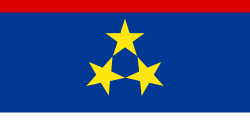
A pall (or pairle) in heraldry and vexillology is a Y-shaped charge, normally having its arms in the three corners of the shield. An example of a pall placed horizontally (fesswise) is the green portion of the South African national flag. [1] [2]
Contents
- Gallery
- Flags with palls
- Flags party per pall
- Flags with charges in pall
- See also
- References
- External links



A pall that stops short of the shield's edges and that has pointed ends to its three limbs is called a shakefork, although some heraldic sources do not make a distinction between a pall and a shakefork. [3] [2] A pall standing upside down is named pall reversed. [3]
An ecclesiastical pall on a shield, or pallium, is the heraldic indicator of archbishoprics. [2] These palls usually have a lower limb that stops short of the bottom of the shield with a fringe. [3]
Palls can also be modified with heraldic lines. [4] One example is the coat of Saint-Wandrille-Rançon, [5] displayed below (third). The wavy heraldic line on a pall can be used to represent a river, or a confluence thereof, as in the arms of Nigeria (the rivers Niger and Benue, which join at Lokoja).
A field may be divided into three parts, tierced per pall (or in pairle), resembling a combination of division per chevron and per pale. [6] [7] Charges may be borne in pall, that is, arranged in a form resembling a pall. [8]
























